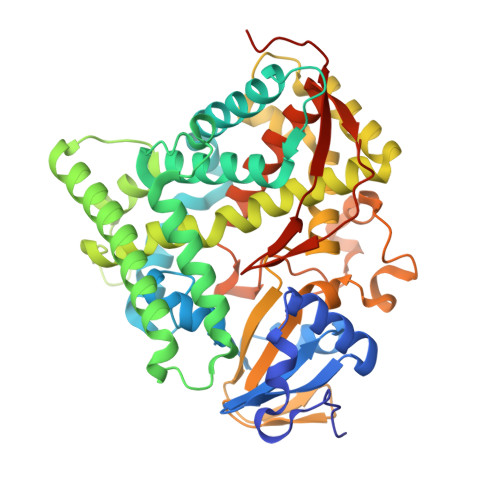Regiodivergent and Enantioselective Hydroxylation of C-H bonds by Synergistic Use of Protein Engineering and Exogenous Dual-Functional Small Molecules.
Chen, J., Dong, S., Fang, W., Jiang, Y., Chen, Z., Qin, X., Wang, C., Zhou, H., Jin, L., Feng, Y., Wang, B., Cong, Z.(2023) Angew Chem Int Ed Engl 62: e202215088-e202215088
- PubMed: 36417593
- DOI: https://doi.org/10.1002/anie.202215088
- Primary Citation of Related Structures:
7YD9, 7YDA, 7YDB, 7YDC, 7YDD, 7YDE, 7YFT, 7YJE, 7YJF, 7YJG, 7YJH - PubMed Abstract:
It is a great challenge to optionally access diverse hydroxylation products from a given substrate bearing multiple reaction sites of sp 3 and sp 2 C-H bonds. Herein, we report the highly selective divergent hydroxylation of alkylbenzenes by an engineered P450 peroxygenase driven by a dual-functional small molecule (DFSM). Using combinations of various P450BM3 variants with DFSMs enabled access to more than half of all possible hydroxylated products from each substrate with excellent regioselectivity (up to >99 %), enantioselectivity (up to >99 % ee), and high total turnover numbers (up to 80963). Crystal structure analysis, molecular dynamic simulations, and theoretical calculations revealed that synergistic effects between exogenous DFSMs and the protein environment controlled regio- and enantioselectivity. This work has implications for exogenous-molecule-modulated enzymatic regiodivergent and enantioselective hydroxylation with potential applications in synthetic chemistry.
Organizational Affiliation:
CAS Key Laboratory of Biofuels and Shandong Provincial Key Laboratory of Synthetic Biology, Qingdao Institute of Bioenergy and Bioprocess Technology, Chinese Academy of Sciences, 266101, Qingdao, China.

















